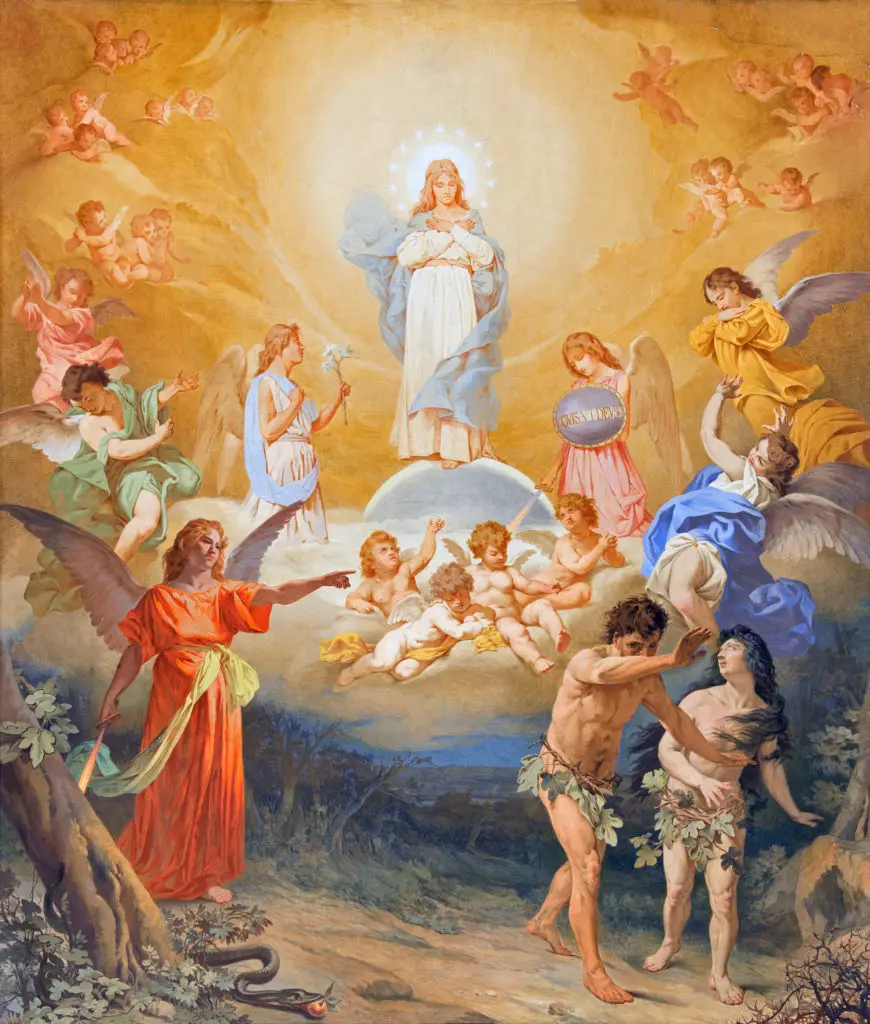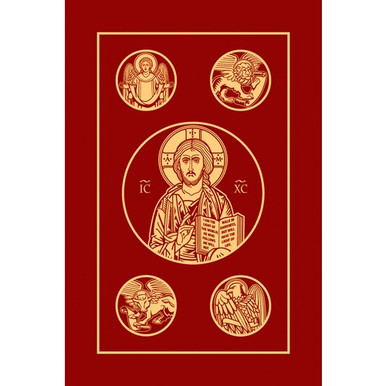This post contains affiliate links.
The concept of the Immaculate Conception refers to the instant that Mary existed in Her Mother’s womb (conception) St Anne and that Mary is free from Original Sin (immaculate). This belief can be traced back to the Bible and the early teaching of the Church.
The Immaculate Conception is the belief that Mary, the Mother of Jesus, is conceived free from Original Sin. The Dogma of the Immaculate Conception was officially defined by Blessed Pius IX in Ineffabilis Deus on 8 December 1854. The Immaculate Conception is both Scriptural and a Traditional teaching of the Church from the earliest centuries.
The ‘Immaculate Conception’ means simply this, that at the instant Mary existed exist in Her Mother’s Womb St Anne, She was preserved from the stain of Original Sin in which all human beings are conceived in and for the vast majority (excepting St John the Baptist (St Luke 1:40-45) and the Prophet Jeremiah (Jeremiah 1:5)), born with Original Sin, therefore the need for Baptism in order to wash away and return God’s Grace into each soul.

It is generally agreed that Mary was conceived by her parents in the ordinary manner. However. because of the future merits of Her Son, Jesus, who is God Incarnate, Mary’s soul was adorned with Sanctifying Grace from the very instant of her existence. She was neither pre-destined nor an after event, it was instantaneous, from conception.
This article of faith or dogmas was officially declared but always believed and announced by God from the words in Genesis 3:15 and at the Annunciation in St Luke’s Gospel (St Luke 1:28).
Blessed Pius IX defined the Immaculate Conception as an article of divine faith on the 8th December, 1854 when he wrote: “To the honor of the Holy and Undivided Trinity, to the glory and adornment of the Virgin Mother of God, to the exaltation of the Catholic Faith and the increase of the Christian religion, by the authority of our Lord Jesus Christ, of the blessed Apostles, Peter and Paul, and by Our own, We declare, pronounce, and define that the doctrine, which holds that the most Blessed Virgin Mary at the first instant of her conception, by a singular grace and privilege of Almighty God, in virtue of the merits of Christ Jesus, the Savior of the human race, was preserved immaculate from all stain of original sin, has been revealed by God, and on this account must be firmly and constantly believed by all the faithful” Ineffabilis Deus 1854.
Recommended Catholic Bibles, Catholic Resource Website and Outstanding Catholic Research Software:
What does the Bible say about the Immaculate Conception?
When considering whether the Immaculate Conception is Biblical or what does the Bible say about the mysterious event, we can ask this in another way:
When did God reveal this mystery?
The Old Testament is a foreteller of the coming Messiah and all the events surrounding the Old Testament lead to the arrival of the Messiah in the New Testament. Therefore, we connect many of the events, words, promises, covenants, and so on in relation to each other.
The writer, Moses, inspired by God wrote the very first announcement of the Messiah which is called the ‘protoevangelium’.
In order to set the scene, the following from the Book of Genesis follows the fall of Adam and Eve into the temptation of the Serpent (Satan). God in His infinite Justice and Mercy issues just punishment to our first parents, however in His mercy, God promises to send a redeemer through a Woman. Below is the reference to this interaction:
“And when they heard the voice of the Lord God walking in paradise at the afternoon air, Adam and his wife hid themselves from the face of the Lord God, amidst the trees of paradise.
And the Lord God called Adam, and said to him: Where art thou?
And he said: I heard thy voice in paradise; and I was afraid, because I was naked, and I hid myself.
And he said to him: And who hath told thee that thou wast naked, but that thou hast eaten of the tree whereof I commanded thee that thou shouldst not eat?
And Adam said: The woman, whom thou gavest me to be my companion, gave me of the tree, and I did eat.
And the Lord God said to the woman: Why hast thou done this?
And she answered: The serpent deceived me, and I did eat.
And the Lord God said to the serpent: Because thou hast done this thing, thou art cursed among all cattle, and beasts of the earth: upon thy breast shalt thou go, and earth shalt thou eat all the days of thy life.

I will put enmities between thee and the woman, and thy seed and her seed: she shall crush thy head, and thou shalt lie in wait for her heel.
To the woman also he said: I will multiply thy sorrows, and thy conceptions: in sorrow shalt thou bring forth children, and thou shalt be under thy husband’s power, and he shall have dominion over thee.
And to Adam he said: Because thou hast hearkened to the voice of thy wife, and hast eaten of the tree, whereof I commanded thee, that thou shouldst not eat, cursed is the earth in thy work: with labour and toil shalt thou eat thereof all the days of thy life.
Thorns and thistles shall it bring forth to thee, and thou shalt eat the herbs of the earth.
In the sweat of thy face shalt thou eat bread till thou return to the earth out of which thou wast taken: for dust thou art, and into dust thou shalt return” (Genesis 3:8-19).
Whilst God’s punishment seems harsh, however when one breaks the command of the Creator and offends God, then as the adage goes, ‘do the crime, do the time’.
The key passage “I will put enmities between thee (the serpent) and the woman, and thy seed and her seed. She shall crush thy head, and thou shalt lie in wait for her heel” (Genesis 3:15).
Recommended Catholic Resource Collection:
The key words from this passage are:
- Serpent and seed.
The is in reference to Satan and all those who do the works of Satan and this includes many of Satan’s evil works.
- The Woman and Her Seed.
Note the singular sense of Woman. It is Her and Her seed that will be opposition to the Serpent and his works.
- Enmity.
The word ‘Enmity’ is defined as ‘hostility, enemies, scorn’.
Therefore the Woman and Her Seed will be at odds or complete opposites to the Serpent and his seed.
To finish off, the Woman (She) shall crush the head of the Serpent and the Serpent will lie in wait for Her heel.
A victory that is promised at some point coupled with a future event. This is the “First Gospel” or “protoevangelium”. The announcement of the Messsiah and a Woman will have a role to play.
Who is this Woman? What does She have to do with the Immaculate Conception?
The Woman spoken in Genesis 3:15 is Mary Herself. St John the Evangelist, whose writing style and commences in a similar way to Genesis 1, never mentions that name of Mary in his Gospel. St John refers to Mary as ‘Woman’ at the Wedding in Cana “And Jesus saith to her: Woman, what is that to me and to thee? My hour is not yet come” (St John 2:4) and again at the Cross “When Jesus therefore had seen his mother and the disciple standing whom he loved, he saith to his mother: Woman, behold thy son” (St John 19:26).
Did St John not know the name of the Mother of Jesus for whom Jesus entrusted to his care?
Off course St John new the name of Jesus’ Mother, however St John is pointing the reader to ‘the Woman’ found in Genesis 3:15.
St John who also wrote the Book of the Apocalypse, again sees ‘the Woman’ as he writes:
“And a great sign appeared in heaven: A woman clothed with the sun, and the moon under her feet, and on her head a crown of twelve stars” (Apocalypse 12:1).
We can deduce from the Genesis 3:15 and reinforced in the writings of St John that the Woman will not be subject to the same conditions of every mortal woman and man.
She (the Woman) will be at odds with the Serpent. Her seed will be Jesus, the Son of God and God Incarnate. For God did not choose to send His Son through a mere mortal woman but a Woman who would be designed for Himself. God chose His own Mother.
Therefore, Mary is free from ALL sin, She is also free from Original sin.
We as Catholics accept the Immaculate Conception on God’s authority, who reveals this truth to us and is a matter of divine revelation.
What does the New Testament say about the Immaculate Conception?
As we mentioned earlier, the Old Testament foretells the New Testament and the New Testament fulfills the Old Testament.
In the New Testament according to Blessed Pius IX, God also revealed this mystery when He bade the angel salute Mary with the words:
“Hail, FULL OF GRACE, the Lord is with thee, BLESSED ART THOU AMONGST WOMEN” (St Luke 1:28).
The great commentator Cornelius a Lapide writes the following on this Angelic Salutation:
“Hail, Ave. It is very probable that the angel used the ordinary salutation of the Hebrews, שּׁלום לך, Peace be to thee.
Unless the opinion of Serarius is to be preferred, that ave is the Hebrew חוה chave or have, that is, “Live;” so that there is an allusion to the name of Eve, which is in Hebrew חוה chava, that is the mother of all living (Gen. 3:20), so that the meaning will be, Eve was not the mother of life but of death, because by sin she delivered over all her children to death, but thou, O Mary, art truly called Eve, because thou art the mother of life, grace, and glory. Hence in Latin ave is Eva reversed, because Mary turned the maledictions of Eve into blessings”.
Cornelius goes on to explain the ‘full of Grace’ part of the greeting in quoting some of the Fathers of the Church. Hence highlighting the earliest understanding of Mary’s Immaculate Conception:
“Highly favoured. Gratia plena, Vulgate, full of grace. Greek, κεχαριτωμένη, when answers to the Hebrew נחנה, filled with grace or made acceptable; …
St. Ambrose and others of the Fathers. … signifies:
1. That the Blessed Virgin had a gift of grace bestowed upon her by God, and that, in a full measure of excellence beyond other just and holy persons, for this epithet is applied solely to the Blessed Virgin, to the end that she might be made worthy to become in time the Mother of God.
2. That she by means of this gift of grace was wonderfully well-pleasing in the sight of God and of all His angels, and in their eyes altogether lovely and beautiful, so that Christ chose her before all others for His mother.
St. Augustine (Serm xviii. de Sanctus) says,
“Mary is filled with grace, and Eve is made clear from guilt; the curse of Eve is changed into the blessing of Mary.”
Toletus (annotat. 67) shows that the Blessed Virgin was full of all grace, both in body and soul. For she was free from concupiscence (fomite concupiscentiæ), so that in her the flesh was subject to the reason and the spirit, as was the case with Adam in Paradise through original righteousness. Wherefore he adds that in her, nature conspired with grace and co-operated with it in every respect. See also what I have said concerning her in the Commentary on the Canticles, especially on those words (c. 4:7), Thou art all fair, my love, there is no spot in thee.
St. Jerome (Serm. de Assump. B. V.) says, “It is well said that she was full of grace, because on others grace is bestowed partially (per partes), but the fulness of grace in complete treasure was infused into Mary.” And again, “The entire fulness of grace, which is in Christ, came upon Mary, although in a different way.”
Suarez shows that the grace possessed by the Blessed Virgin in the first instant of her conception was greater than the grace which the highest angel possesses, … she had increased the degrees of grace and merit to such an extent that she altogether excelled in them all men and angels taken together. Wherefore she by herself alone is more acceptable to God than all the rest; and God loves the Blessed Virgin alone more than the whole Church, that is, more than all men and angels taken together.”
In thus revealing Mary’s unique fullness of Grace, God at the same time reveals her preservation from original sin. In other words, He reveals the Immaculate Conception.
Like her Divine Son, therefore, Mary was wholly sinless.
Jesus was sinless by nature; Mary was sinless by Grace.
Jesus by Excellence; Mary by privilege.
Jesus as Redeemer; Mary, as the first to be sanctified by His precious Blood.
What does the early Church teach (Tradition) about the Immaculate Conception?
In addition to the quote from Cornelius a Lapide the early Church has always held to the belief that Mary is Immaculately Conceived.
The early Fathers of the Church unanimously speak of Mary’s holiness and Immaculate Conception:
The Apostle St Andrew’s testimony as recorded in the celebrated letter of the priests of Patras, which relates his martyrdom writes:
“…. first man was created of immaculate earth, it was necessary that the perfect man should be born of an immaculate Virgin, through whose means the Son of God, who had before created man, might repair that eternal life which had been lost through Adam.”
The celebrated comparison between Eve, whilst yet immaculate and incorrupt, that is to say, not subject to original sin, and the Blessed Virgin, is drawn out by St. Justin (c. 100- c. 165 AD), St. Irenæus (c. 130 – c. 202AD), Tertullian (c. 160 – 220AD), St. Cyril of Jerusalem (313-386AD), and St. Epiphanius (310 – 403AD).
St. Justin (c. 100- c. 165 AD) says:
“He was made from a Virgin, that the way by which disobedience took its beginning from the serpent, by the same it might receive its destruction. For whilst Eve was yet a Virgin and incorrupt, having conceived the words spoken to her by the serpent, she brought forth disobedience and death. But the Virgin Mary, when she had received faith and joy, as Gabriel announced to her the glad message, that the Spirit of the Lord should descend in her, and the power of the Most High should overshadow her, … gave answer: Be it done to me according to Thy word.”
St. Hippolytus, Bishop and Martyr (c. 170 – 235AD), says, speaking first of our Saviour: “He was the ark formed of incorruptible wood. For by this is signified that His tabernacle was exempt from putridity and corruption, which brought forth no corruption or sin. But the Lord was exempt from sin, of wood not obnoxious to corruption according to man; that is, of the Virgin and of the Holy Ghost, covered within and without with the pure gold of the word of God.”
Origen (c. 184 – c. 253AD), or the ancient author of the Homilies attributed to him, thus speaks of the Mother of God: “This Virgin Mother of the Only-begotten of God is called Mary, worthy of God, immaculate of the immaculate, one of the one.”
In the fourth century, St. Ephræm (303 – 373AD) extolled the Blessed Virgin in streams of the sweetest and most melodious eloquence.
In a prayer to the Blessed Mother of God, he calls her: “Immaculate and uncontaminated, incorrupt and thoroughly chaste, and a virgin most estranged from every soil and stain of sin, the Spouse of God and our Lady, ….
St. Augustine (354-430AD), in his book on Nature and Grace, replied, that all the just had truly known sin: “Except,” he says, “the holy Virgin Mary, of whom, for the honor of the Lord, I will have no question whatever when sin is concerned. For whence can we know the measure of grace conferred on her to vanquish sin on
“We do not transfer Mary to the devil by the condition of her birth, for this reason, that that condition is dissolved by the grace of her new birth.”
By the seventh century, the Eastern Church celebrated the feast of Mary’s Conception.
By the eighth century, it was generally held among the faithful of the East that her conception was immaculate.
The feast was subsequently introduced in Spain and Italy and then throughout the rest of Europe.
In 1568, when Pope Pius V’s Missal appeared, he extended the feast of the Immaculate Conception to the universal Church.
In Summary:
Through the sin of our first parents, each of us inherits this Sin, called Original Sin. To repair the damage caused by Adam and Eve, God calls upon His design of the Immaculate Virgin.
The earth brought forth two virginal humans who were created in God’s Grace.
Through a singular Grace and privilege, God brought forth His Mother, Immaculately Conceived, a Virgin who brought Jesus, God Incarnate.
The Immaculate Conception is Biblical (Divinely revealed), a long held belief (Tradition) and a declared Dogma worthy of belief and part of the Deposit of Faith.






